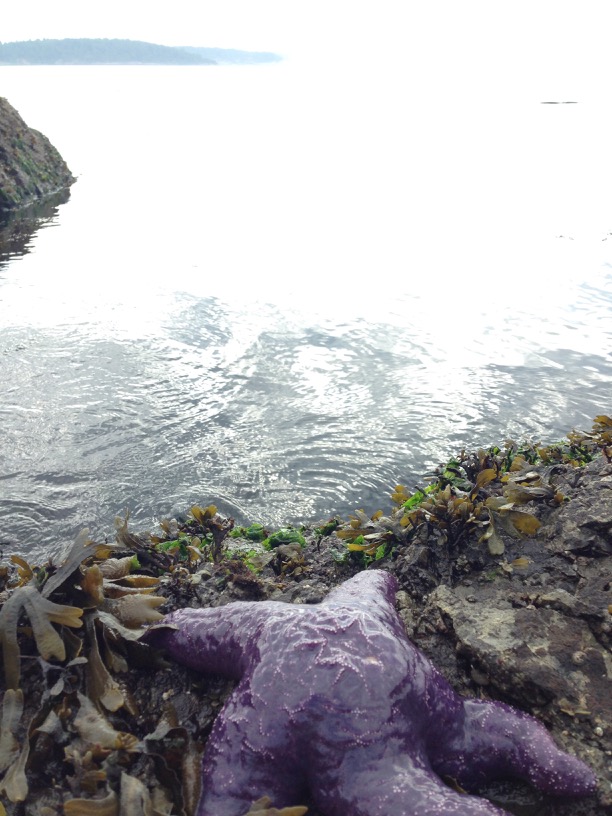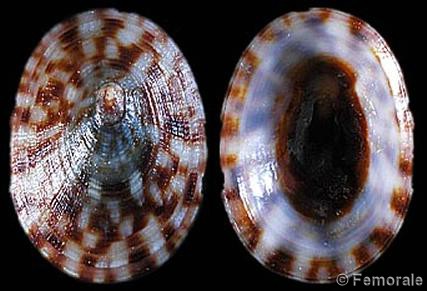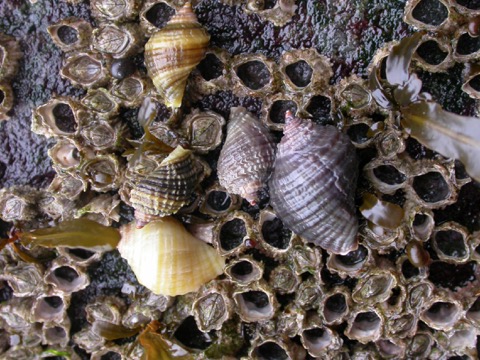inverts
Friday Harbor
12/05/16 12:47
Done teaching for the spring. Whew.
For the first time, however, I'm actually teaching in the summer. I've done a Maymester course with Jim Hamrick for OTS, but generally I use the summer for research, travel, R&R, writing proposals. This year I'm delighted to be an instructor at Friday Harbor marine lab, one of the most amazing places in the world to be a biologist and interact with other amazing biologists.
One of the few downsides, however, is that to do research there - the exact projects we have proposed - means getting our act together ahead of time, knowing exactly what we need and when we need it. A lot of equipment and supplies are already at FHL, but that doesn't mean they are laying dormant waiting for us. Cooperating with the whole crew at Friday Harbor is, of course, part of the experience of getting research done close to the field (unless you are lucky enough to live there!).
So, this month is a good time for me to be in the lab. All the undergrads are gone, and as it turns out after 20 years I'm pretty good at rocking out a PCR here, a gel there, organizing equipment and supplies, and thinking of how amazing it will be when I'm there.
For the first time, however, I'm actually teaching in the summer. I've done a Maymester course with Jim Hamrick for OTS, but generally I use the summer for research, travel, R&R, writing proposals. This year I'm delighted to be an instructor at Friday Harbor marine lab, one of the most amazing places in the world to be a biologist and interact with other amazing biologists.
One of the few downsides, however, is that to do research there - the exact projects we have proposed - means getting our act together ahead of time, knowing exactly what we need and when we need it. A lot of equipment and supplies are already at FHL, but that doesn't mean they are laying dormant waiting for us. Cooperating with the whole crew at Friday Harbor is, of course, part of the experience of getting research done close to the field (unless you are lucky enough to live there!).
So, this month is a good time for me to be in the lab. All the undergrads are gone, and as it turns out after 20 years I'm pretty good at rocking out a PCR here, a gel there, organizing equipment and supplies, and thinking of how amazing it will be when I'm there.

Baby It's Cold Outside
13/12/10 09:17
We woke in Athens to -6°C and winds, which made me really appreciate my building more than usual by the time I arrived after the 10 minute bike ride to get here. Figured it was time I updated before the semester is completely gone. Our lab did make it out to celebrate the end of a pretty good semester, we all (well, almost all, there was a final the next day...) headed to Trappeze to warm our insides and toast to our shared dislike of leafblowers. Most of all, it is good to have a lab full of people who get along and keep their heads, and maintain their enthusiasm in sweet and hard times about their passion for science. It was kind of a rough week in that regard, we had all together three papers rejected in recent days (but one accepted). The other papers will find the light soon enough.
Speaking of papers that need to find the light, I offer the following linked manuscript up to the science gods. This is a short paper that was orphaned from my dissertation, and this summer I challenged myself to write a manuscript on these data in one day. I actually took two, or parts of two, days knowing that it was only a tiny descriptive study of a limpet and perhaps no more interesting than the Genbank numbers contained within, but I guess I hope the data will be useful to somebody who is starting their graduate work and is considering work on Tectura testudinalis. David Reid is a wonderful colleague who I met at the CORONA meetings, and he was kind in his rejection, so I’m going to put this one into a web bottle and cast it to sea.
Wares_Tectura
The paper isn’t wrong, just insufficient. But the limpets are nice, so good luck little paper.
Our final news for the lab would be that we managed to earn three awards at the Genetics Department holiday party, I can’t remember which categories Christine’s entries were in but the vegan chickpea-spinach Indian-style dish I made got a blue ribbon in the vegetarian category, I’ll be sure to dogear that page in my cookbook!
Also if you are looking for entertaining reads on evolution and/or bees, check out the work of Jay Hosler (an image is on the “Invert Comics” page), a biologist who has combined his knowledge and skills as a cartoonist to generate some pretty interesting outreach.
Speaking of papers that need to find the light, I offer the following linked manuscript up to the science gods. This is a short paper that was orphaned from my dissertation, and this summer I challenged myself to write a manuscript on these data in one day. I actually took two, or parts of two, days knowing that it was only a tiny descriptive study of a limpet and perhaps no more interesting than the Genbank numbers contained within, but I guess I hope the data will be useful to somebody who is starting their graduate work and is considering work on Tectura testudinalis. David Reid is a wonderful colleague who I met at the CORONA meetings, and he was kind in his rejection, so I’m going to put this one into a web bottle and cast it to sea.
Wares_Tectura

The paper isn’t wrong, just insufficient. But the limpets are nice, so good luck little paper.
Our final news for the lab would be that we managed to earn three awards at the Genetics Department holiday party, I can’t remember which categories Christine’s entries were in but the vegan chickpea-spinach Indian-style dish I made got a blue ribbon in the vegetarian category, I’ll be sure to dogear that page in my cookbook!
Also if you are looking for entertaining reads on evolution and/or bees, check out the work of Jay Hosler (an image is on the “Invert Comics” page), a biologist who has combined his knowledge and skills as a cartoonist to generate some pretty interesting outreach.
Marine Biology
13/10/10 15:15
How funny is it to call yourself a marine biologist?
McSweeney’s knows it is funny.
Seinfeld knew it was funny.
And with colleagues like J-Long, it IS funny.
After the hairy theory/numerical/simulation Genetics paper our lab group read today though, I’d rather call myself a marine biologist any day!
McSweeney’s knows it is funny.
Seinfeld knew it was funny.
And with colleagues like J-Long, it IS funny.
After the hairy theory/numerical/simulation Genetics paper our lab group read today though, I’d rather call myself a marine biologist any day!
North Atlantic
07/10/10 10:46
It’s funny, I made my start as a population geneticist championing the cause of the North Atlantic Ocean, and I don’t think about it as often these days. Our careers creep in many funny directions, sometimes pulled by funding opportunities and sometimes by fortuitous collaboration.

The above image was snared from the website of Geoff Trussell’s lab at Northeastern University. Geoff is one of my many great colleagues that I know from interactions at the CORONA meetings and every year that I can make it to the Benthic meetings on the east coast (and really, who would want to miss these meetings? Nice one, Jeremy...). Anyway, the image is primarily of the dogwhelk, Nucella lapillus. A really beautiful snail, lots of color variation, interesting genetic patterns, part of my dissertation.
The work is finally being updated, with modern statistical (ABC) approaches, by my good friend and colleague Mike Hickerson and his student and postdoc (particularly lead author Katriina Ilves). The results are clearly starting to change. There are taxonomic controls on who survived glaciation and who didn’t - on the east coast of North America, at least - rather than larval life history controls, if the statistics tell the whole story. What is amazing is how big of an impact that paper had in 2001, and I suspect this paper will have a big impact in 2010.... and yet we still clearly know so little. Most of these species have still only been assayed for mitochondrial variation. The time will come soon when we can apply for funding to tackle the same community using variation across the entire genome.

The above image was snared from the website of Geoff Trussell’s lab at Northeastern University. Geoff is one of my many great colleagues that I know from interactions at the CORONA meetings and every year that I can make it to the Benthic meetings on the east coast (and really, who would want to miss these meetings? Nice one, Jeremy...). Anyway, the image is primarily of the dogwhelk, Nucella lapillus. A really beautiful snail, lots of color variation, interesting genetic patterns, part of my dissertation.
The work is finally being updated, with modern statistical (ABC) approaches, by my good friend and colleague Mike Hickerson and his student and postdoc (particularly lead author Katriina Ilves). The results are clearly starting to change. There are taxonomic controls on who survived glaciation and who didn’t - on the east coast of North America, at least - rather than larval life history controls, if the statistics tell the whole story. What is amazing is how big of an impact that paper had in 2001, and I suspect this paper will have a big impact in 2010.... and yet we still clearly know so little. Most of these species have still only been assayed for mitochondrial variation. The time will come soon when we can apply for funding to tackle the same community using variation across the entire genome.